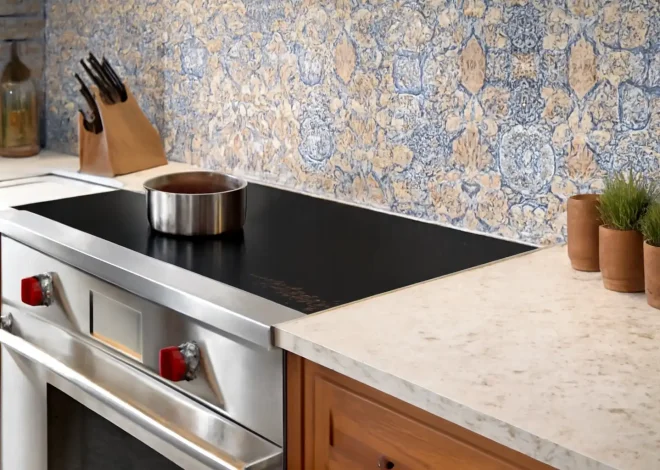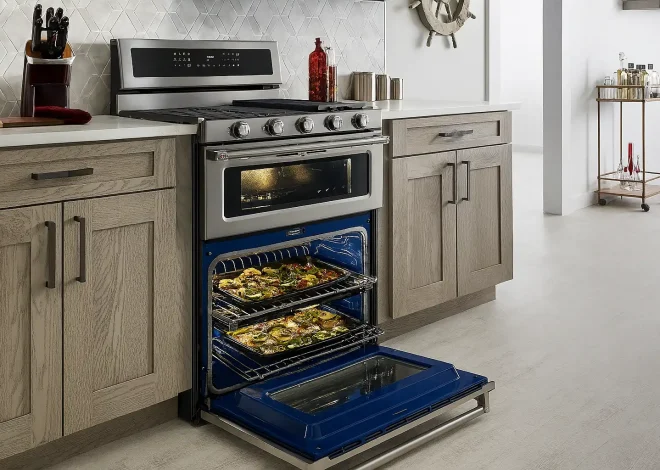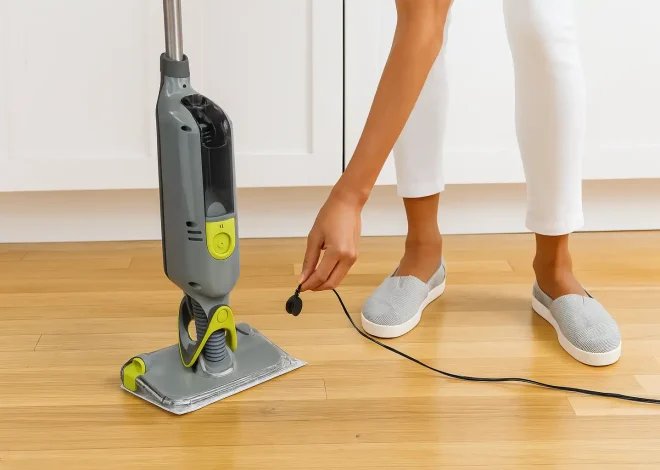
How to Dispose of Knives Safely and Responsibly | Reviewed
When people ask me how to dispose of knives, I always share what I learned the hard way. Once, I carelessly tossed an old knife in the trash, and it led to a small injury when someone tried to take the bag out. Since then, I’ve made it a habit to wrap the sharp blade with thick cardboard, then bundle it with tape. This way, the knife is concealed and much safer to throw away. If you’re wondering how to dispose of a knife or how to dispose of knives safely, this simple step can save someone from getting hurt and help manage residential waste.
Knowing how to dispose of knives properly also means thinking beyond just tossing them in the garbage. I often tell friends to check with their local waste services. Some have special drop-off spots for metal tools. Whether it’s an old chef’s blade or a broken utility knife, always choose the right way to discard it, ensuring it doesn’t end up in the curbside trash. If there’s an emergency cleanup or you’re handling multiple blades, label the package and keep it secure. It might seem small, but learning how to properly dispose of knives can make a big difference in safety and responsibility, particularly in managing residential waste.
Practical Tips for Responsible Knife Disposal at Home
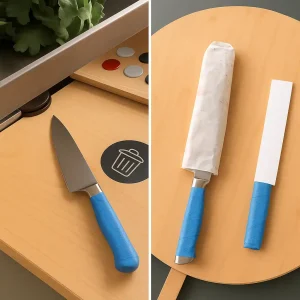
Growing up in a household where cooking was a daily affair, we went through many old, dull knives that we simply threw away. One day, my dad reached into the trash and suffered a nasty injury. That made us realize how important it is to know how to dispose of knives properly. Even dull blades can be dangerous, so learning how to dispose of knives safely helps prevent serious accidents.
The safest habit I picked up was learning how to dispose of knives responsibly. First, wrap the blade tightly in thick paper or cardboard and seal it with tape, just as you would with any other kitchen utensil that needs proper disposal. This step helps conceal the edges and lowers the risk for sanitation workers or anyone handling the bag, preventing potential injuries from debris.
Next, check with your community waste management on local rules for how to dispose of knives safely. Some areas require you to label it clearly or bring it to a designated drop-off. Never toss knives loosely, they can be a hidden hazard, even after being thrown away. Prioritizing safety while you dispose of these tools ensures peace of mind for everyone involved.
Why Is It Crucial to Dispose of Knives Properly?
During my early days in food service, I saw someone toss old blades straight into the trash, unaware of the dangers posed by leaving them unprotected among other debris—much like the careless disposal of scissors. Not long after, a cleaner suffered a cut while emptying the garbage, an accident that could have been easily avoided with better awareness of how to dispose of knives properly. That moment was an eye-opener. It clearly showed me that not knowing how to dispose of knives the right way can quickly lead to an emergency. Even worn-out knives remain dangerously sharp, and without proper handling, they can cause serious injury.
So if you’ve ever wondered how you dispose of knives, the key is to always wrap them well using cardboard, thick paper, or any protective material before you dispose of them in a waste collection bin. Learning how to dispose of knives correctly is a simple habit that protects others. Whether you’re a home cook or just clearing out drawers, knowing how to dispose of knives properly makes a big difference in overall safety.
Why Throwing Knives Away the Wrong Way is a Big Mistake
From my personal experience in handling home safety and waste disposal, I’ve learned that getting rid of sharp items like knives needs serious attention. Many people wonder, can you throw knives in the trash? While it may seem like the easiest option, it’s not the safest. Dropping a knife into a plastic bag or garbage can without care can cause real harm.
I’ve seen people suffer a painful cut just by trying to take out the trash. Imagine reaching in with your hand, not realizing what’s inside, and ending up with an unexpected injury. It might even lead to an emergency if the wound is deep, especially if a shard is left behind. These accidents are more common than you’d think.
The truth is, what are the risks of improper knife disposal at the curbside is a question that should always be taken seriously. Doing it the wrong way risks not only your safety but also others who may reach into that bag, including family, neighbors, or sanitation workers who might pick up the wrong item at the curb. One small mistake can lead to a big accident, especially if a shard of metal is left exposed.
How to Dispose of Knives Safely
When it comes to how to dispose of knives safely, the key is to prevent any injury or harm within your community. Learning how to dispose of knives properly means always wrapping the sharp blade securely, using thick paper or cardboard, and then concealing it inside a sturdy container before putting it out on garbage day.
Knowing how to dispose of knives this way helps keep emergency workers and neighbors safe from accidental cuts or wounds caused by accumulated sharp objects. From my own experience, understanding how to dispose of knives with care not only protects others but also gives peace of mind, knowing you’re contributing to overall safety in your neighborhood. Taking the time to master how to dispose of knives safely is a small effort with a big impact on public health and well-being. For more tips on safe disposal and kitchen safety, you can check out resources like BestVouch, which offers helpful guidance on everyday household practices.
Identifying When It’s Time to Dispose of Your Knives
Knowing how to dispose of knives is key to keeping your kitchen safe and ensuring that they are not mistakenly placed in the recycling bin. If your kitchen knives become too dull to cut well or are badly damaged, it’s often better to discard them rather than try to repair. When wondering how to dispose of knives safely, remember that trying to fix knives with broken handles or deep chips can be dangerous. Many people ask how to dispose of knives or how to dispose of old knives safely, and often seek answers on platforms like Quora.
The best way is to wrap the blade securely before you throw away or dispose of these old knives to prevent injury to yourself or others. Understanding how to dispose of knives properly helps keep your home safe and tidy, so learning how to dispose of knives the right way is very important.
How can you tell if a knife is no longer usable?
From my own experience, how to dispose of knives starts with knowing when a knife is no longer usable. Usually, it comes down to how it feels and works during cooking, much like selecting the right utensil for the task. If the knife is dull or not sharp, it won’t do a good job at slicing or dicing — tasks that are key for smooth cooking performance. Learning how to dispose of knives properly is important because old knives that don’t cut well can slow you down and even be unsafe, much like using rusty scissors.
Also, if the blade is damaged, like bent or chipped, it’s a clear sign you shouldn’t keep using it. Knowing how to dispose of knives safely means you can avoid injuries and keep your kitchen organized. That’s why understanding how to dispose of knives and when to part with them is a smart habit for every cook. So, before your next cooking session, think about how to dispose of knives when they stop working well..
Knowing when to dispose of a knife is just as important. If sharpening no longer fixes the blade or the handle feels loose, it’s time to let the knife go and consider a proper pickup or recycling option. A knife that doesn’t work properly makes cooking frustrating and could lead to accidents, so don’t wait too long to say goodbye to knives that have lost their edge.
What signs indicate that a knife should be disposed of instead of repaired?

From my experience, knowing how to dispose of knives safely begins with recognizing signs a knife can’t be repaired, such as excessive rust or a loose handle. If a knife has a dull edge that won’t sharpen properly or a bent blade, it becomes unusable and not functional. A broken handle also makes the knife unsafe to use, increasing the risk of someone getting cut.
Additionally, old knives that show heavy wear or damage are usually not worth repairing. When you notice these issues, it’s best to stop fixing the knife and focus on disposing of it safely to avoid accidents or poor kitchen performance
Are there specific knives that require different disposal methods?
Yes, different types of kitchen knives need different ways to be thrown away safely. For example, a small paring knife or utility knife can be wrapped tightly in cardboard or thick paper before disposal to avoid cutting anyone. Larger knives like a bread knife or a sharp chef’s knife should be handled with more care, sometimes it’s better to take them to a recycling center or hazardous waste site. From my experience, securely taping old blades and placing them inside a sturdy box makes disposing of kitchen knives much safer for everyone involved, especially during collection days.
Some knives, like a throwing knife, may need special attention due to their design and sharpness. If you’re wondering how you dispose of kitchen knives like these, it’s best to check local rules or donate to Goodwill if possible to promote their usefulness. When dealing with how to dispose of old kitchen knives, always package them securely in rigid plastic to prevent injuries during disposal.
How to Dispose of Knives
When you wonder how to get rid of knives or how to discard knives safely, the key is to wrap and secure the blades well to protect anyone handling the trash from getting cut. From my experience, using newspaper or cardboard works great to cover sharp edges. You want to double-wrap the knife, then seal it tightly with heavy-duty tape, ensuring that it is safe to place in the recycling bin or a cardboard box. This extra step keeps the blade from cutting through the wrapping or hurting sanitation workers.
Once your knife is safely wrapped, place it inside a sturdy box or container. This makes it easier to throw away or discard along with the rest of trash. Always make sure the container is closed well, so nothing pokes out when you put it in the garbage can. This simple but careful method answers the question of how do you throw away knives without risk or injury, ensuring a safer process similar to donating to charity. It’s practical and something I always follow to keep safety a priority when cleaning out old or broken knives.
Safe Disposal Methods for Knives
If you want to learn how to throw out knives safely, it’s best to never toss them loosely into trash bins. The blade can cause serious harm if left exposed. Wrapping knives using materials like cardboard or newspaper protects both you and trash handlers. After wrapping, secure everything firmly with heavy-duty tape and place the knife in a cardboard box or container before you throw it away. This approach ensures the knife stays secure and contained, making knife disposal safe for everyone involved.
How to Dispose of Knives Safely
When thinking about how to throw away a knife, the best practices for knife disposal start with safety and care, ensuring that they are not treated like regular recyclables. From my experience, the key is to wrap the blade securely to avoid any issues with residential waste. I usually use newspaper or cardboard to cover the sharp edge, then add tape around it tightly so it won’t slip out. This simple step helps to conceal the blade and prevent accidents, ensuring that it is disposed of properly in residential waste. After that, placing the wrapped knife inside a sturdy box makes it even safer to handle.
To finish, make sure the box is closed well and labeled if needed, so anyone handling the trash knows to be careful, particularly with sharp utensils inside. This way, you can safely dispose of knives without risking cuts or injuries, ensuring they are placed in the correct receptacle. The whole process is about keeping both yourself and others safe while getting rid of sharp objects.
How can you prepare knives for disposal to prevent injuries?
When thinking about how to safely dispose of knives, the best way I’ve found is to wrap the blade carefully in cardboard or thick paper and place it in a cardboard box for added safety. This helps to conceal the sharp edges and reduces the chance of cuts. After wrapping, use strong tape to keep everything tightly closed. This step is very important for injury prevention because it stops the knife from cutting through and hurting someone handling the trash.
Next, place the wrapped knife inside a sturdy garbage bag to add an extra layer of safety. Make sure the knife is secure and won’t move around inside the bag. When I first started doing this, I realized how easy it is to accidentally injure yourself or the sanitation workers if knives aren’t prepared properly. So these simple steps of wrap, conceal, tape, and secure make a big difference in keeping everyone safe when you ask yourself, “how do I dispose of kitchen knives?”
How to Dispose of Knives Legally and Safely
When figuring out how to dispose of knives legally, it’s important to first check the local knife disposal regulations in your municipality. Every place has different rules, and some may require you to bring knives to a specific recycling center or transfer station instead of just tossing them in the dump, which often leads to broken glass and other debris.
I’ve found it really helpful to visit the official website of your local government, where you can often find clear guidance on the correct way to get rid of sharp objects like knives. This prevents any safety hazards and keeps the disposal process smooth and lawful, especially when dealing with residential waste.
Alternative Options to Disposal Knives
If you’re wondering what to do with old knives instead of just throwing them away, there are several smart and kind ways to handle them. One option is to donate knives that are still usable and in good shape. Many soup kitchens and shelters welcome donations of clean, second hand kitchen tools, so consider donating to Goodwill as well. You might ask yourself, can you donate knives to Goodwill or thrift stores, and if so, how should they be prepared? Yes, you usually can, as long as the knives are safe and clean. This not only helps reduce waste but supports people in need.
Another great idea is to learn how to recycle old knives or how to recycle kitchen knives properly. Metal recycling centers often accept knives because they can be melted down and reused. If recycling isn’t an option nearby, think about how to repurpose old knives in creative ways, maybe as garden tools or art pieces, or even consider using them as scissor holders. From my experience, cleaning the knives thoroughly before donating or recycling is crucial to make sure they are safe and hygienic for their next use.
Can You Donate Knives That Are Still in Good Condition?
If your knives are still usable, one smart way to get rid of them is to donate knives instead of throwing them away. Many donation centers like Goodwill, Salvation Army, shelters, soup kitchens, and secondhand stores accept kitchen tools. Before you donate, check their rules. When donating old kitchen knives, it’s important to pack them safely in a labeled box or plastic container to avoid accidents.
From my experience, properly packed donations make it easier for these charitable places to handle and give the quality knives to people who need them, rather than risking injury. Plus, donating to places like Goodwill may help you file taxes with a donation receipt. So, instead of wondering how to dispose of old knives, donating is a useful and kind option that can extend their usefulness.
How to Recycle Kitchen Knives Safely and Easily

If you’re wondering how to recycle kitchen knives or how you recycle old kitchen knives, the answer lies in treating them as scrap metal. Most local recycling centers or transfer stations accept metal items like knives, but not all take them directly because knives can be sharp and dangerous, which is why it’s important to check with police stations for proper disposal methods.
From my experience, it’s best to first wrap the knives carefully in newspaper or cardboard to protect workers and then take them to a facility that handles metal recycling. This way, you help the environment by keeping knives out of the dump and giving the stainless steel a chance to be reused.
If you want to find knife recycling near me, check with your local recycling center or municipal waste services. Sometimes, special programs or events allow people to drop off sharp metal items safely. Remember, recycle old knives properly by not throwing them in regular trash to avoid harm and pollution. Wrapping knives in cardboard or newspaper is a simple step that makes a big difference in safe disposal and recycling.
How to Get Rid of Old Knives with Creative Reuse Ideas
If you wonder how to dispose of knife properly instead of simply throwing it away, consider the creative reuse of knives by turning them into something useful or artistic. For example, the metal blades can be transformed into unique gardening tools like small scrapers or plant markers. The knife handles, often made of carbon steel, can make great parts for handmade crafts or art projects, adding a vintage or rustic feel and enhancing their usefulness.
One inspiring approach to how to dispose of knife safely and sustainably is to repurpose it into new kitchen tools or decorative items, giving the blade a second life. When thinking about how to dispose of knife without contributing to landfill waste, creative reuse is a smart and eco-friendly solution.
From my experience, working with old knives this way not only helps reduce waste but also sparks creativity, turning them into recyclable art pieces. Using worn blades and sturdy handles in DIY projects is surprisingly rewarding, and the results can be functional or purely decorative, especially when repurposing quality knives. This approach feels much better than just tossing dull blades away and lets you enjoy a hands-on way to recycle.
Responsible Knife Disposal: Sharing Safety and Knowledge
Knowing how to dispose of knives responsibly is important for everyone’s safety, just as it is with other kitchen utensils. When you decide how to get rid of kitchen knives, it’s best to use clear steps to avoid accidents. Wrap blades carefully, use sturdy containers, and check local resources for special disposal programs. By doing this, you take responsibility for keeping your home and community safe.
I’ve found that sharing safe knife disposal tips with friends and family helps spread awareness. When we educate others on proper knife disposal, it builds a safer environment for everyone. It’s a simple way to show care and promote good habits, ensuring no one gets hurt by discarded kitchen knives. Together, we can make a real difference by being mindful and informed.
How to Dispose of Knives Safely and Responsibly
When thinking about how to dispose of knives safely, the key is to wrap the blade carefully and secure it well before you discard it. This protects anyone handling the trash and supports community safety by preventing accidents. I always use thick cardboard or bubble wrap, then tape it tightly so the sharp edges won’t poke through, ensuring safety like when handling other sharp kitchen utensils to prevent anyone from getting cut.
If the knife is still in good condition, consider donating it to a charity or thrift shop instead of throwing it away. For blades that are too damaged, look into a safe disposal program or local guidelines that allow you to recycle stainless steel knives properly. This way, you help reduce waste while keeping everyone safe.
How to Dispose of Knives Safely and Responsibly
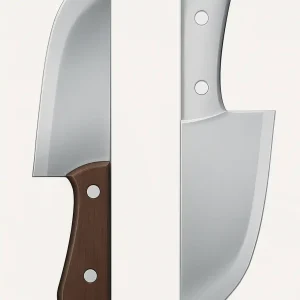
When wondering how to dispose of knives properly, the best step is to look for reliable resources for knife disposal. From my experience, checking websites that specialize in waste management or local government portals gives clear advice. Many cities have specific city regulations and local authority guidance about handling sharp objects to keep everyone safe. You might find detailed instructions about wrapping knives or dropping them off at designated spots.
Another helpful option is to visit your nearest recycling center or donation centers that accept labeled cardboard for safe disposal. Some recycling centers accept knives if they are prepared correctly, and certain donation centers may take knives in good condition for reuse. Using these channels not only helps the environment but also follows the right safety rules set by your municipality. Exploring these resources will make the process simple and responsible.
Why It’s Important to Teach Knife Disposal Safety and Share Safe Knife Disposal Knowledge
From my experience, sharing safe knife disposal knowledge is more than just a helpful tip; it’s a responsibility that protects everyone in the community. Teaching others how to dispose of knives properly, especially when using a recycling bin for old utensils—can make a significant difference. When you raise awareness about how to dispose of knives safely, you help prevent injuries and encourage thoughtful waste habits. It’s not just about tossing things away, but understanding how to dispose of knives in a way that puts safety and sustainability first.
I’ve seen firsthand how careless disposal can lead to accidents, so teaching these simple safety steps feels like a small but powerful charitable act that benefits all. It’s about creating a culture where everyone takes part in keeping others safe, turning knowledge into real-world care and caution, particularly concerning the proper disposal of broken glass and sharp utensils.
FAQs
How do you dispose of kitchen knives?
Wrap the knife in newspaper or cardboard, secure with tape, and label it to warn waste management personnel. This is the recommended method for safe disposal.
How do you get rid of a set of knives?
Place each knife wrapped in old used plastic film into a dumpster that is emptied directly into a compactor without anyone touching the waste. This method helps keep disposal safe and hands-free.
How do you dispose of kitchen knives?
Wrap the knife in newspaper or cardboard, secure with tape, and label it to warn waste management personnel. This is the recommended method for safe disposal.
How do you get rid of a set of knives?
Place each knife wrapped in old used plastic film into a dumpster that is emptied directly into a compactor without anyone touching the waste. This method helps keep disposal safe and hands-free.
